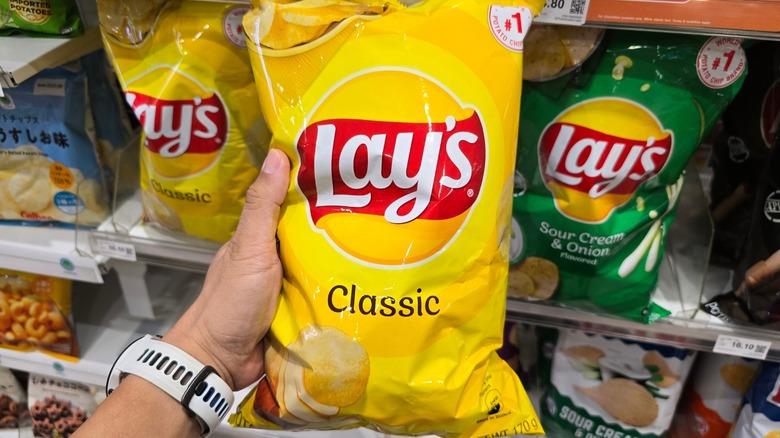The Staggering Price Of Potato Chips In The 1950s Vs Now
Walking through today's grocery store feels like a constant game of sticker shock. Even within the past few decades, we've noticed prices skyrocketing. But when we compare it to the 1950s, those prices are even more shocking. Take Herr's potato chips. In 1953, the brand's 12-ounce bag of potato chips cost 49 cents, just 4 cents an ounce. Today, that same bag would cost about $8.66, or 72 cents an ounce, depending on your location.
Although this is just one brand, it speaks to a larger trend. Nowadays, it would be virtually impossible to find a decently sized bag of chips for less than 50 cents. The Federal Reserve Bank of St. Louis reports that the average price of a 16-ounce bag of potato chips is $6.97 (roughly 44 cents an ounce). Pricing obviously varies depending on brand, location, and store. Store-brand chips are often cheaper — but just as flavorful — as their name-brand counterparts. And Clancy's Potato Chips are a prime example of affordable Aldi snacks that make you forget about name brands.
Despite good deals, we can't deny that the price of potato chips has been steadily increasing for decades, with a sharp upturn in recent years. At the beginning of 2020, the average 16-ounce bag was about $4.50. By 2025, it was $6.50, a whopping $2 more. These potato chip prices feel like they're outpacing inflation. And while inflation is definitely a factor, it's not the only issue causing prices to soar.
Why are potato chip prices increasing?
Food products aren't immune to inflation. When raw ingredients cost more, chip production costs rise. Think water for crops, oil for frying, transportation fuel, labor, and land fees. Chip companies typically increase price tags to make up the difference. However, Sherwood News reports that the price of chips has increased 30.6% in the past five years, while the consumer price index has only increased 20.6%. So what other factors are at play?
Climate change is one major culprit. Potatoes need a cool climate to grow, and as temperatures increase, farmers are experiencing smaller yields. While Idaho and Washington are famous for potato production, Pennsylvania holds the title of "The Potato Chip Capital of the World" thanks to numerous potato chip factories. The state grows some potatoes, but not enough to keep up with demand. Climate change only exacerbates this. And when chip companies need to ship potatoes from distant states, production costs increase.
As potato chip prices soar, consumers are feeling increasingly salty. Many are turning to discount brands and private labels to offset the high cost. If this sounds like you, but you're disappointed by cheaper brands, try heating your store-bought potato chips in the oven for an instant upgrade. And if you're looking to cut spending even more, consider making your own potato chips. Just remember to season your homemade potato chips while they're still wet from being fried, so they can soak up all those yummy flavors.


